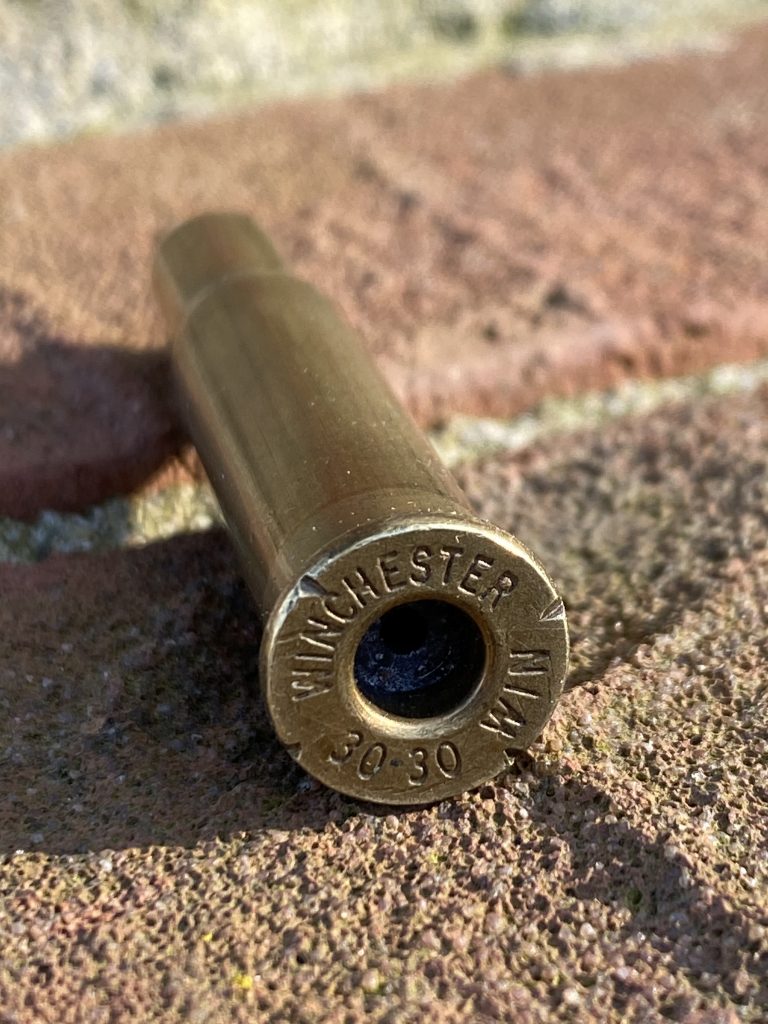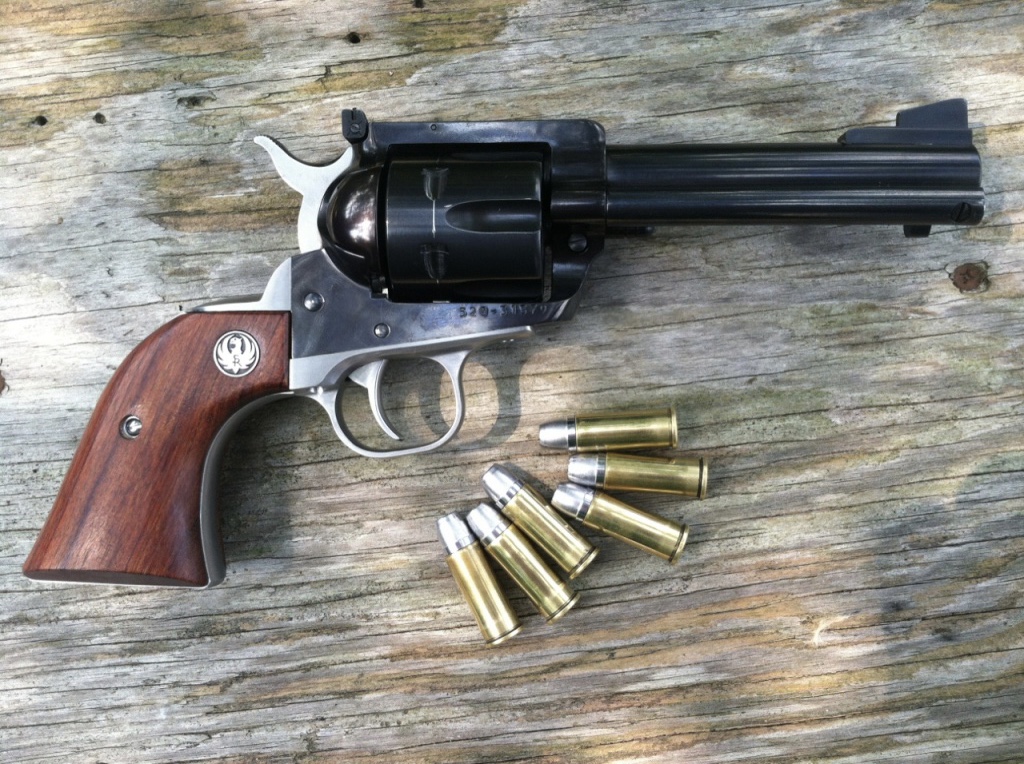Post by LeverGunner on Aug 30, 2024 21:03:30 GMT -5
I posted this on the Castboolit forum originally (2019), but after reading another thread here though it'd be of interest.
I posed the question of "How many loadings to expect on full length sized 30-30 brass?" sometime back. The responses I received were anywhere from "not many" to the usual suggestion of "why full length size when neck sizing is better for brass life".
So I decided to do a little test. I took a once fired winchester case and loaded it until failure, keeping a record of each loading. I marked it's head with 4 file marks so I could easily distinguish it. I loaded it anytime I loaded a batch of 30-30, and sometimes loaded it singularly as well.

The case was full length sized after each firing, and then measured. From the first trimming until the case grew past the maximum length it wasn't trimmed. Then, it was trimmed to minimum length after each firing. Sometimes the trim length was short due to my inconsistent use of the trimmer or using the test casing to set the trimmer. I inside chamfered and outside deburred every time the case was trimmed. A roll crimp was used every loading. I did not anneal the case during this test.
The gun is my Winchester 94 30-30 made in 1970.
Tools used, Lyman FL sizing die set (a few times I used a CH FL sizing die but did not record which times), Lyman M die, lyman universal case trimmer. I used both a Lyman Spartan and a Lee hand press. For lube it was imperial sizing wax or Hornady one shot with no recorded distinction. RCBS calipers.
Cast bullets were all from air cooled, clip on wheel weights, sized .309 with Hornady gas checks. Lube was BAC on the Lyman 31141, LLA on the Lee 309-150-FN.
Times fired, powder & charge, bullet, length after sizing, trim to length.
1. Factory fired, trimmed to 2.029
2. W748 29.0 gr, Lee 309-150-FN, 2.029
3. W748 29.0 gr, Lee 309-150-FN, 2.032
4. W748 29.0 gr, Lee 309-150-FN, 2.032
5. W748 29.0 gr, Lee 309-150-FN, 2.035
6. W748 29.0 gr, Lee 309-150-FN, 2.036
7. W748 29.0 gr, Lee 309-150-FN, 2.0365
8. W748 29.0 gr, Lee 309-150-FN, 2.038
9. W748 29.0 gr, Lee 309-150-FN, 2.039
10. W748 29.0 gr, Lee 309-150-FN, 2.041, TTL 2.027
11. Misfired factory bullet & powder, 2.032, TTL 2.028
12. W748 34.0 gr, Lyman 31141, 2.027, no trim
13. W748 32.0 gr, Lyman 31141, 2.029, TTL 2.026
14. W748 32.5 gr, Lyman 31141, 2.027, no trim
15. W748 32.5 gr, Lyman 31141, 2.031, 2.029
16. W748 32.5 gr, Lyman 31141, 2.032, 2.027
17. Unique 9.2 gr, Lee 309-150-fn no GC, 2.030, TTL no record
18. W748 32.5 gr, Lee 309-150-fn, 2.030, TTL 2.028
19. W748 32.5 gr, Lyman 31141, 2.032, TTL 2.028
20. W748 32.5 gr, Lyman 31141, 2.029, TTL 2.028
21. W748 32.5 gr, Lyman 31141, 2.029, TTL 2.027
22. IMR 3031 27.0 gr, Lyman 31141, 2.030, failure
That is a total of .040 trimmed off by my figuring, giving a value of .003 for number 17 which I forgot to record the trim length.
After load 22 was fired, I resized using a Lyman full length hand die. After sizing, inspection revealed a crack on the shoulder. I decided to size with the hand die as the base of the body just above the web was slightly bulged and beginning to chamber with a slight resistance. This was the only time using the hand die, and I wonder if it caused the crack prematurely. Probably not.

After each firing I carefully inspected the case for cracks and defects. I paper clip tested many times, and every time when I started getting up in firings. The primer pocket remains tight.
I started this test with the intent to record the number of times fired between trim to length and max length. It then turned into a longevity test. Obviously this isn't conclusive as it dealt with only one case of one manufacture. Not to mention the variables I introduced with varying trim lengths, size dies (mostly Lyman), presses used, and case lube used. It has been fun for me, and I've learned that full length sizing is not the 5-8 load brass killer I've heard, at least in my chamber with my dies, and my loading techniques.
Using a 357 magnum case as a comparitor, my die is moving the shoulder back .039. I still have some ammo that was loaded back when I did this test, and the test case was probably loaded in that batch even. That older loaded ammo, and a newly sized case both measure the same .039 of setback from a fire formed case. I checked to make certain that the shell holder was indeed bottoming out when sizing as I have some spring in my press. I was quite surprised at this level of movement and the amount of loading cycles I got before failure.
That brings me to another facet of the test, how much can I trim off before I need to worry about the brass thinning and incipient case head separation. Of course that would depend on the thickness of the brass, which will vary from lot to lot and manufacturer. The Lyman manual in a round about way suggests that .060 is the safe cut off spot.
I eventually plan to do a test of 3 cases, and record the group size for them to see how that changes over the course of their lifespan.
I posed the question of "How many loadings to expect on full length sized 30-30 brass?" sometime back. The responses I received were anywhere from "not many" to the usual suggestion of "why full length size when neck sizing is better for brass life".
So I decided to do a little test. I took a once fired winchester case and loaded it until failure, keeping a record of each loading. I marked it's head with 4 file marks so I could easily distinguish it. I loaded it anytime I loaded a batch of 30-30, and sometimes loaded it singularly as well.

The case was full length sized after each firing, and then measured. From the first trimming until the case grew past the maximum length it wasn't trimmed. Then, it was trimmed to minimum length after each firing. Sometimes the trim length was short due to my inconsistent use of the trimmer or using the test casing to set the trimmer. I inside chamfered and outside deburred every time the case was trimmed. A roll crimp was used every loading. I did not anneal the case during this test.
The gun is my Winchester 94 30-30 made in 1970.
Tools used, Lyman FL sizing die set (a few times I used a CH FL sizing die but did not record which times), Lyman M die, lyman universal case trimmer. I used both a Lyman Spartan and a Lee hand press. For lube it was imperial sizing wax or Hornady one shot with no recorded distinction. RCBS calipers.
Cast bullets were all from air cooled, clip on wheel weights, sized .309 with Hornady gas checks. Lube was BAC on the Lyman 31141, LLA on the Lee 309-150-FN.
Times fired, powder & charge, bullet, length after sizing, trim to length.
1. Factory fired, trimmed to 2.029
2. W748 29.0 gr, Lee 309-150-FN, 2.029
3. W748 29.0 gr, Lee 309-150-FN, 2.032
4. W748 29.0 gr, Lee 309-150-FN, 2.032
5. W748 29.0 gr, Lee 309-150-FN, 2.035
6. W748 29.0 gr, Lee 309-150-FN, 2.036
7. W748 29.0 gr, Lee 309-150-FN, 2.0365
8. W748 29.0 gr, Lee 309-150-FN, 2.038
9. W748 29.0 gr, Lee 309-150-FN, 2.039
10. W748 29.0 gr, Lee 309-150-FN, 2.041, TTL 2.027
11. Misfired factory bullet & powder, 2.032, TTL 2.028
12. W748 34.0 gr, Lyman 31141, 2.027, no trim
13. W748 32.0 gr, Lyman 31141, 2.029, TTL 2.026
14. W748 32.5 gr, Lyman 31141, 2.027, no trim
15. W748 32.5 gr, Lyman 31141, 2.031, 2.029
16. W748 32.5 gr, Lyman 31141, 2.032, 2.027
17. Unique 9.2 gr, Lee 309-150-fn no GC, 2.030, TTL no record
18. W748 32.5 gr, Lee 309-150-fn, 2.030, TTL 2.028
19. W748 32.5 gr, Lyman 31141, 2.032, TTL 2.028
20. W748 32.5 gr, Lyman 31141, 2.029, TTL 2.028
21. W748 32.5 gr, Lyman 31141, 2.029, TTL 2.027
22. IMR 3031 27.0 gr, Lyman 31141, 2.030, failure
That is a total of .040 trimmed off by my figuring, giving a value of .003 for number 17 which I forgot to record the trim length.
After load 22 was fired, I resized using a Lyman full length hand die. After sizing, inspection revealed a crack on the shoulder. I decided to size with the hand die as the base of the body just above the web was slightly bulged and beginning to chamber with a slight resistance. This was the only time using the hand die, and I wonder if it caused the crack prematurely. Probably not.

After each firing I carefully inspected the case for cracks and defects. I paper clip tested many times, and every time when I started getting up in firings. The primer pocket remains tight.
I started this test with the intent to record the number of times fired between trim to length and max length. It then turned into a longevity test. Obviously this isn't conclusive as it dealt with only one case of one manufacture. Not to mention the variables I introduced with varying trim lengths, size dies (mostly Lyman), presses used, and case lube used. It has been fun for me, and I've learned that full length sizing is not the 5-8 load brass killer I've heard, at least in my chamber with my dies, and my loading techniques.
Using a 357 magnum case as a comparitor, my die is moving the shoulder back .039. I still have some ammo that was loaded back when I did this test, and the test case was probably loaded in that batch even. That older loaded ammo, and a newly sized case both measure the same .039 of setback from a fire formed case. I checked to make certain that the shell holder was indeed bottoming out when sizing as I have some spring in my press. I was quite surprised at this level of movement and the amount of loading cycles I got before failure.
That brings me to another facet of the test, how much can I trim off before I need to worry about the brass thinning and incipient case head separation. Of course that would depend on the thickness of the brass, which will vary from lot to lot and manufacturer. The Lyman manual in a round about way suggests that .060 is the safe cut off spot.
I eventually plan to do a test of 3 cases, and record the group size for them to see how that changes over the course of their lifespan.



